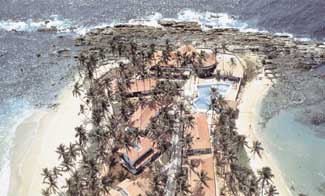

![]()

Sea, sky and lively nights! |
Contents |
When Prince Charles comes to Sri Lanka for the jubilee independence celebrations, a visit to the Royal Botanical Gardens would be of special significance to him as it was here that his favourite uncle, Louis Mountbatten had his headquarters during the second world war. But unfortunately not much evidence of the headquarters exists today. Hiranthi Fernando reports
As Kandy gets spruced up to celebrate Sri Lanka's
fifty years of Independence, the Royal Botanical Gardens at Peradeniya
prepares to receive a royal visitor. Prince Charles, the Prince of Wales
who has been invited to grace the independence celebrations plans to visit
the Botanical Gardens during his stay in Kandy. During the second world
war, the headquarters of  the
South East Asia Command under the Late Lord Louis Mountbatten as Supreme
Allied Commander was sited at the Royal Botanical Gardens of Peradeniya.
The Prince's main interest in visiting the Botanical Gardens is to see
where Lord Mountbatten, who is said to have been his favourite uncle, had
his headquarters.
the
South East Asia Command under the Late Lord Louis Mountbatten as Supreme
Allied Commander was sited at the Royal Botanical Gardens of Peradeniya.
The Prince's main interest in visiting the Botanical Gardens is to see
where Lord Mountbatten, who is said to have been his favourite uncle, had
his headquarters.
Unfortunately, not much evidence of Lord Mountbatten's headquarters exists today. "The South Asia Command headquarters consisted of a number of buildings scattered over a large area of the Gardens around the Great Circle," Mr. Sumithraarachchi, Director, Royal Botanical Gardens said. Lord Mountbatten's own office complex had been sited in the Great Circle which is now a large circular lawn, the building on it completely demolished. Sited nearby was the Secret Mission headquarters. This building has survived and is now used as the office of the Superintendent of the Botanical Gardens. However, an extension has been added to the building thus covering the frontal view of the old building. The old section has an extremely high ceiling and covers an extensive floor area. The large rooms have now been partitioned into smaller rooms and cubicles. The original walls of the building are about 18 inches thick.
According to Mr. Sumithrarachchi, the Armoury and gunpowder store were situated in a building on the Great Lawn, further south of the Great Circle. On this lawn is the beautiful Giant Java Willow Tree with its magnificent spread of branches. This site is now occupied by a restaurant. The former soil laboratory of the Botanical Gardens was converted to the library of the South Asia Command. It is now occupied by the Superintendent of the Gardens.
Around the Great Circle, memorial trees have been planted to commemorate visits of Royalty, Heads of State, religious dignitaries, other important persons and of interesting events. This tradition which dates back to the colonial era still continues today. Among these memorial trees is one named Amherstia Nobilis planted by Lord Mountbatten on July 21, 1945. The oldest memorial trees to be seen here are a Ficus Religiosa or Bo tree planted by King Edward V11 far back in 1875, and a Na or Ceylon Ironwood tree planted by the Czar of Russia in 1891. Also seen among others are a Cannon Ball tree planted by King George V and Queen Mary in 1901 and a Ficus Krishnae or Gotu Na tree planted by Queen Elizabeth 11 in 1954 and another planted by the Duke of Edinburgh. To commemorate Independence Day on February 4, 1948, D.S. Senanayake planted a Tamarind tree. During his visit to the Botanical Gardens, Prince Charles too will be invited to plant a tree to commemorate his visit to Sri Lanka.
"I looked after the garden around the headquarters," said elderly Jamis who had then been working in the arboretum of the Botanical Gardens. Jamis who knows the Gardens well, now guides visitors around. "The armoured vehicles used to be parked in the arboretum around the Great Circle, where they could be camouflaged by the trees," he recalled. The garden area around the office was planted in "Nidhikumba." It looked beautiful with the tiny pink flowers. A minor punishment meted out to soldiers was to weed this lawn. "There were about 5000 soldiers working in the headquarters," Jamis said. "There were British, Americans, Punjabis and Africans. Lord Mountbatten's office was situated here from 1942 till the end of the war in 1945."According to Jamis, Lord Mountbatten resided in Kundasale but also had a restroom at the Gardens.
People in the area say that a secluded estate bungalow at Yahalatenne, about six kilometers from Kandy was also used by Lord Mountbatten as a retreat. This bungalow which now forms a part of the Tree of Life Hotel, was an estate bungalow built almost a hundred years ago. During the colonial era, it was set amidst 700 acres of tea owned by the British. A large lawn in front completely bordered by trees, was used to play croquet.
The Botanical Gardens, which is usually kept in good order, is being given a face lift in preparation for the visit of Prince Charles. It will be closed to the public on that day. To continue the old tradition, a tree planting ceremony is being held when Prince Charles will be asked to plant a tree close to those planted by his parents and his sister Princess Anne. Yet another member of Royalty will thus be honoured at the Royal Botanical Gardens.
Continue to Plus page 2 * The fall of a King
![]()
| HOME PAGE | FRONT PAGE | EDITORIAL/OPINION | NEWS / COMMENT | BUSINESS
Please send your comments and suggestions on this web site to
info@suntimes.is.lk or to
webmaster@infolabs.is.lk